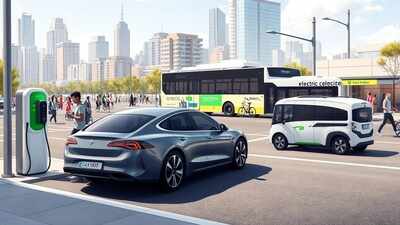
India’s EV Growth At Risk : Crisil Warns Of Rare Earth Magnet Shortage Impact
Table of Contents
India’s ambitious electric vehicle (EV) push could be headed for a bumpy ride, warns a recent report by Crisil, as the global shortage of rare earth magnets poses a serious threat to the country’s EV supply chain. These high-performance magnets — primarily Neodymium-Iron-Boron (NdFeB) — are crucial for manufacturing electric motors used in EVs. With limited domestic production and heavy reliance on imports, particularly from China, India’s green mobility roadmap is at risk of stalling.
What Are Rare Earth Magnets, And Why Do EVs Need Them?

Fortuner Neo Drive 2025 Launched in India : A Bold Hybrid Leap for Indian Roads🚗
Rare earth magnets, especially NdFeB magnets, are known for their strong magnetic fields, thermal stability, and compact size — making them ideal for EV traction motors. These magnets are used in permanent magnet synchronous motors (PMSMs), the preferred motor type for most modern electric vehicles due to their efficiency and power density.
India, like many other nations, is betting big on EVs to reduce dependence on fossil fuels, cut emissions, and improve air quality. However, this transition is highly dependent on a stable and cost-effective supply of rare earth materials.
Crisil’s Warning: Magnet Shortage May Hit India’s EV Targets
In its recent report, Crisil highlighted that the shortage of rare earth magnets could lead to higher costs and supply delays, derailing India’s EV adoption plans in the short to medium term. As per Crisil, India imports almost all its magnet requirements, mostly from China, which dominates global rare earth mining and magnet manufacturing.
Crisil estimates that demand for NdFeB magnets in India could grow 15-20 times by 2030, largely driven by the EV sector and wind energy projects. However, without a local magnet manufacturing ecosystem or a diversified supply chain, this growth could be constrained.
Global Magnet Crunch: A Supply Chain Squeeze
The rare earth magnet shortage isn’t just an Indian problem. As the world races to adopt EVs and green technologies, the demand for rare earths is outstripping supply. According to industry experts, NdFeB magnet demand could triple by 2035, driven by:
- Global EV sales boom
- Renewable energy expansion (wind turbines also need magnets)
- Defense and electronics sectors’ increasing magnet use
Yet, rare earth mining and magnet production remain highly concentrated in China, which controls around 90% of the global magnet manufacturing market. This leaves countries like India vulnerable to supply disruptions, price volatility, and geopolitical risks.
India’s EV Ambitions vs. Magnet Dependency

India has set an ambitious goal of achieving 30% EV penetration by 2030. Automakers, startups, and the government are all aligned on this transition. However, EV manufacturers face rising costs due to:
- Import duties on rare earth magnets
- Fluctuating prices driven by global demand
- Long lead times and supply bottlenecks
This can delay EV deliveries, increase vehicle prices, and slow down mass adoption — especially in cost-sensitive segments like two-wheelers and affordable cars.
2026 Audi Q3 Breaks Cover Globally: Design, Features, Specs, Price & All You Need to Know
Is There a Way Out? Domestic Sourcing & Innovation
Recognizing the strategic importance of rare earths, India has begun exploring local reserves of minerals like monazite, which contains neodymium and other rare earth elements. However, mining and processing these minerals is capital-intensive, environmentally challenging, and time-consuming.
Several policy and industrial steps are being considered:
- Rare Earth Exploration: Efforts by Indian Rare Earths Limited (IREL) and Department of Atomic Energy to tap reserves in Kerala, Tamil Nadu, and Odisha.
- PLI Incentives: Government may include NdFeB magnet manufacturing in Production Linked Incentive (PLI) schemes.
- Magnet Recycling: Startups and research labs are exploring urban mining — extracting rare earths from discarded electronics and motors.
- Motor Alternatives: Some EV companies are evaluating induction motors or ferrite magnet motors, which are less efficient but cheaper and easier to source.
Industry Voices: What Automakers and Experts Are Saying
Auto majors like Tata Motors, Mahindra, and Ola Electric are aware of the looming magnet crunch. While most are still dependent on imports, some are working with local partners to explore alternatives.
According to Rohan Joshi, an automotive analyst, “EV makers need to build magnet strategies just like battery strategies. Localization of critical components is the next frontier.”
Experts also emphasize the need for strategic reserves, bilateral supply agreements with other rare earth-producing nations (like Australia and Vietnam), and greater R&D investments in alternative motor tech.
The Road Ahead: Urgent Need for Magnet Policy
Crisil’s report makes it clear: unless India takes urgent steps to secure its magnet supply chain, its EV ambitions could be significantly slowed down. Policymakers must prioritize this under the broader “Make in India” and “Atmanirbhar Bharat” agenda.
With the right mix of exploration, investment, and innovation, India can reduce its dependence on imports and build a resilient, localized EV ecosystem.
Conclusion
India’s EV revolution is on the fast track, but the shortage of rare earth magnets is a potential derailment point. Crisil’s warning should serve as a wake-up call to industry and government alike. The time to act is now — to ensure the wheels of India’s clean mobility dream keep turning without magnetic disruptions.
